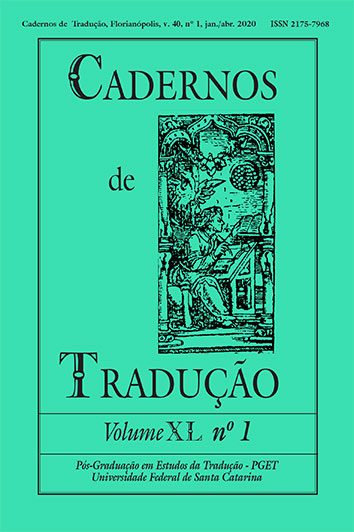Machine translation: a critical look at the performance of rule-based and statistical machine translation
DOI:
https://doi.org/10.5007/2175-7968.2020v40n1p54Abstract
The essay provides a critical assessment of the performance of two distinct machine translation systems, Systran and Google Translate. First, a brief overview of both rule-based and statistical machine translation systems is provided followed by a discussion concerning the issues involved in the automatic and human evaluation of machine translation outputs. Finally, the German translations of Mark Twain’s The Awful German Language translated by Systran and Google Translate are being critically evaluated highlighting some of the linguistic challenges faced by each translation system.Literaturhinweise
Arnold, Douglas, Lorna Balkan, Siety Meijer, R. Lee Humphreys, and Louisa Sadler. Machine translation: An introductory guide. Oxford: Blackwell, 1994.
Callison-Burch, Chris, Miles Osborne, and Philipp Koehn. “Re-evaluating the role of BLEU in machine translation research,” 2006. http://homepages.inf.ed.ac.uk/pkoehn/publications/bleu2006.pdf. Accessed 13 February 2019.
Costa-Jussà, Marta R., Mireia Farrús, José B. Mariño, and José A. R. Fonollosa. “Study and comparison of rule-based and statistical Catalan-Spanish machine translation systems.” Computing and Informatics, 31 (2012): 245-270.
Farrús, Mireia, Marta R. Costa-Jussà, and Maja Popović. “Study and correlation analysis of linguistic, perceptual, and automatic machine translation evaluations.” Journal of the American Society for Information Science and Technology, 63.1 (2012): 174-184.
Forcada, Mikel L. (2010). “Machine translation today.” Handbook of translation studies. Ed. Yves Gambier and Luc van Doorslaer. Amsterdam: John Benjamins, 2010. 215-223.
Hutchins, W. John, and Harold L. Somers. An introduction to machine translation. London: Academic Press, 1992.
Kalyani, Aditi, Hemant Kumud, Shashi Pal Singh, Ajai Kumar, and Hemant Darbari. “Evaluation and ranking of machine translation output in Hindi language using precision and recall oriented metrics.” International Journal of Advanced Computer Research, 4.14 (2014): 54-59.
Koehn, Phillip. Statistical machine translation. Cambridge: Cambridge University Press, 2010.
Schneider, Michael. “Die schreckliche deutsche Sprache.” https://www.hmtm-hannover.de/uploads/media/Die_schreckliche_deutsche_Sprache_06.pdf. Accessed 13 February 2019.
Snover, Matthew, Bonnie Dorr, Richard Schwartz, Linnea Micciulla, and John Makhoul. “A study of translation edit rate with targeted human annotation,” 2006. https://www.cs.umd.edu/~snover/pub/amta06/ter_amta.pdf. Accessed 13 February 2019.
Somers, Harold L. “Machine translation: History, development, and limitations.” The Oxford handbook of translation studies. Ed. Kirsten Malmkjaer and Kevin Windle. Oxford: Oxford University Press, 2011. 427-440.
Twain, Mark. “The awful German language.” https://www.cs.utah.edu/~gback/awfgrmlg.html#x1. Accessed 14 May 2018.
Quah, Chiew Kin. Translation and technology. New York: Palgrave Macmillan, 2006.
Zydroń, Andrzej, and Qun Liu. “Measuring the benefits of using SMT.” MultiLingual, 1/2 (2017): 63-66. http://dig.multilingual.com/2017-01-02/index.html?page=63. Accessed 13 February 2019.
Downloads
Veröffentlicht
Zitationsvorschlag
Ausgabe
Rubrik
Lizenz
Autores têm autorização para assumir contratos adicionais separadamente, para distribuição não exclusiva da versão do trabalho publicada nesta revista (ex.: publicar em repositório institucional ou como capítulo de livro, com reconhecimento de autoria e publicação inicial nesta revista).





















































